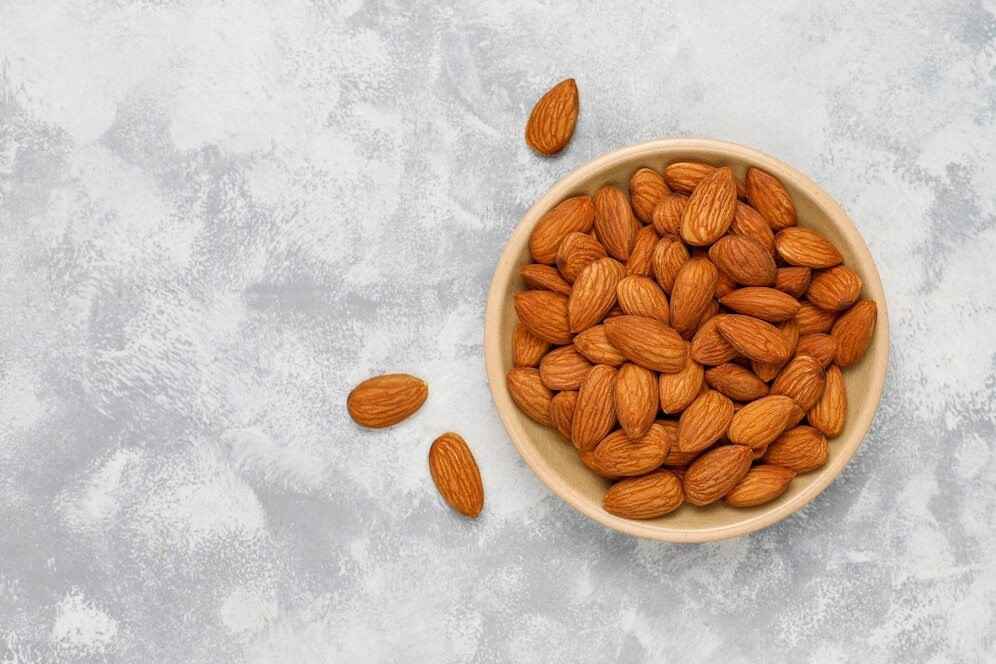Almond: health benefits,recipes, Mamra type and more
Mamra almond is a superior quality of almonds. Almonds come from the prunus family – the same as peaches, cherries and apricots! To begin, it’s probably best to point out that almonds aren’t actually nuts. In fact, they are the seed of an almond tree. It is a stone fruit, which means it has a fleshy exterior and a pit on the inside, like cherries, peaches, and plums.
So, then, what exactly is a nut? The shells of nuts are indeed quite tough (like acorns or chestnuts). If it helps, the food industry now refers to almonds as “culinary nuts.” Almonds are tasty and nutritious, and you can include them in various recipes.
It doesn’t matter if they’re sprouted or not; they’re always crunchy and tasty, whether they’re raw, roasted, sweet, or salty. Today, almonds are very popular among healthy eaters. They come in many different kinds, such as Mamra almonds, which can be sorted by color, shape, and size. California, home to many of Hollywood’s biggest names, is also the world’s leading producer of almonds. Again, we can call it a nut, but almonds are tree seeds. They can play a variety of roles in your diet. If you are looking for a good source of protein, almond butter is what you need. As a salad dressing, they can also be used as a source of fat that will keep you fuller for longer. Almonds are an energy-dense snack that give you enough energy to make it through till dinnertime. No matter what function almonds play in your diet, they’re both taste and health winners.
What Is Almond (Badam)?
The almond (Badam) tree produces drupe fruits, which are more commonly referred to as nuts; however, the almond is actually a drupe fruit (Prunus dulcis; Prunus amygdalus). Almonds are primarily grown in the United States, Spain, and Italy, but they are native to North Africa, West Asia, and the Mediterranean. Raw or roasted, this versatile nut can be enjoyed plain or in various dishes. If you’re looking for a sweet or savory treat, almonds can make that happen, and they are a common ingredient in many recipes.
Almond trees were first farmed as early as 3000 BC. Almonds are mentioned as a treasured food given as a gift in the first book of the Bible, Genesis. The edible part of the almond, as previously stated, is a seed from a drupe fruit; we normally don’t eat the outer shell and hull layers of a drupe fruit. These shells and hulls are typically used for feeding livestock and bedding after the almond seed has been removed.
Dietitians often suggest including almonds in a well-balanced diet because of the numerous health benefits they’ve been connected to. In the United States, almonds are the most popular nut. In recent years, almonds have gained a reputation for their variety and health benefits, making them popular with dieters.
According to the USDA, the demand for almonds in the United States has surged by more than 500 percent since 1980. As of 2021, people of America ate an average of 2.47 pounds (1116 grams) of almonds per person, a 35% to 40% rise over 2016.
Origin of Almond, Where Was It Found At First?
Let’s take a look at the Almond origin. People from all parts of the world have appreciated almonds (Badam) for centuries! Almonds have made the journey from their ancient Mediterranean origins to the modern-day. During the past 30 years alone, the almond industry has grown by more than quadrupling in production. Where did almonds come from, and how far back can we go in their history? Continue reading to learn more.
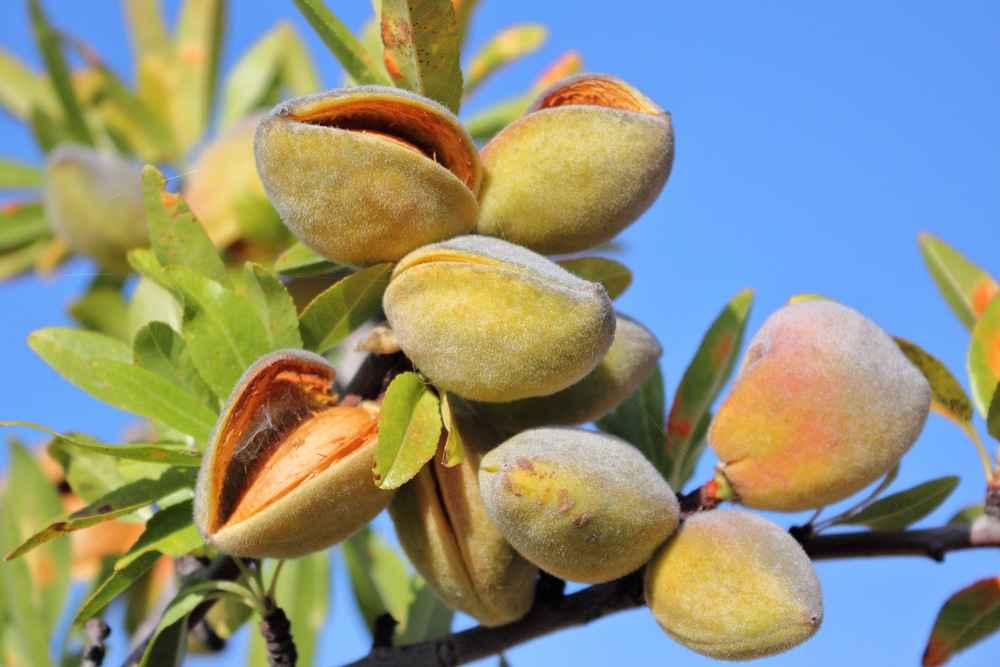
Almond Origin
How Far Back Almonds Were Mentioned in History?
There is a rich history of almonds that can be traced back to ancient times. Our ancestors may have foraged almonds in Western and Central Asia before they were domesticated in 4000 BC when they were planted and spread over Asia. From 600 to 900 AD, travelers crossing the ‘Silk Road’ between Asia and the Mediterranean benefited from the nutritional benefits of almonds, leaving uneaten kernels over Italy and Spain and promoting almond cultivation worldwide. For 100 years after the first almond trees arrived in California, scientists worked to establish an almond cross-breed that would survive in the state’s drier climate. Now they are cultivated in various countries around the globe.
Almonds throughout Time
Almond origin can also be traced to Nomadic tribes in the 4th century BC that ground-up almond kernels for high-energy, on-the-go snacks, just as we do today. Pharaoh Tutankhamen was buried with almonds to preserve him in the afterlife, and we know that they were also valued for their nutritional richness.
Besides archaeological evidence, we also see references to almond trees and fruit, such as in the Bible, in historical documents. Almond blossoms and fruit are characterized as ‘the best in the land’ in the Bible. Almonds’ reputation as a sign of wealth, prosperity, and decadence has endured for millennia, from the Greeks to the Romans to us today.
The origin of almonds also goes back to Christmas dinner in Scandinavian countries, including a rice pudding called julgrot, which contains an almond. According to legend, whoever receives the almond will have good fortune for the rest of the year. In Germany, the bride and groom were given five almonds bundled together to desire a long life, happiness, prosperity, well-being, and fertility, whereas, in Czechoslovakia, guests were given almond sprigs.
Also, almonds in odd numbers of three, five, or seven for christenings, weddings, and religious ordination rituals are offered as signs of good fortune and pleasure. For Jews, a combination of shelled almonds and raisins is a good luck omen.
In many Mediterranean nations, almonds are still seen as a symbol of good fortune and are given to guests during celebrations. As a symbol of hope and good luck, almonds are also thought to aid fertility, supported by scientific evidence!
Today
Many non-dairy products are now made from almonds in the last 30 years; these include milk substitutes like almond butter, almond cheese, and even chocolate. California has quadrupled its almond production, making it the world’s leading almond producer when it comes to almonds. Almond production is now carefully regulated, with almonds graded according to various quality control aspects. Also, some varieties of almonds, such as Mamra almonds, weren’t so popular in the past thirty years.
Because of its flavor, nutritional richness, extended shelf life, ease of transportation, and diversity, almonds are expected to be an important part of people’s lives for many years ahead. Now that you know about Almond origin let’s learn about its various types and uses.
Different Types Of Almond And Their Uses
Almonds come in various shapes, sizes, and flavors. Different countries have different types of almonds. But if you want to be more general, we have two almonds variety. Sweet almond (P. dulcis variety dulcis) and bitter almond (P. dulcis variety amara).
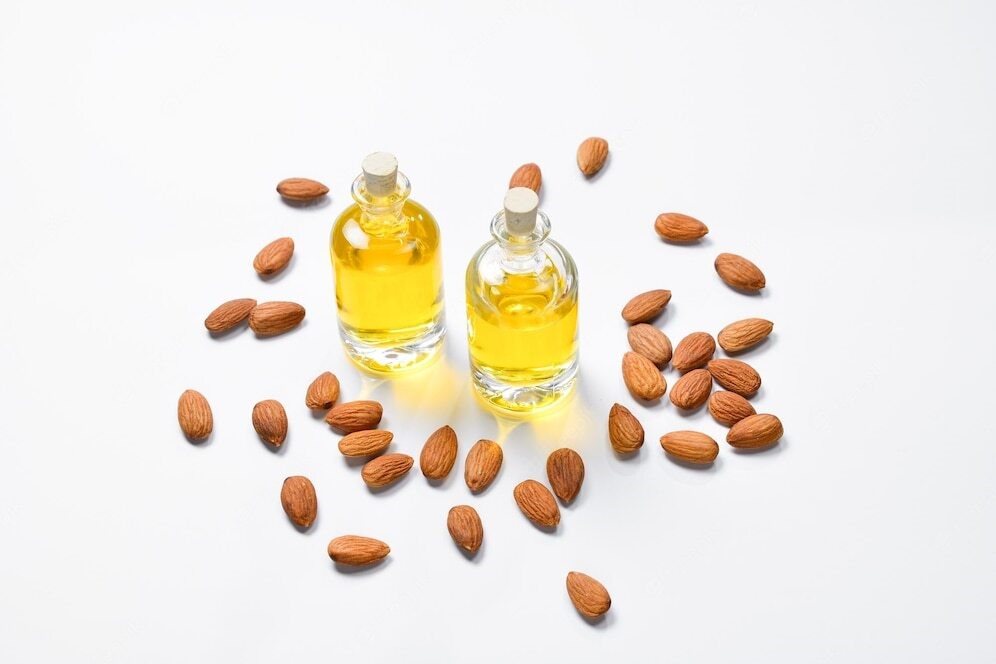
Almond oil
Sweet
Sweet almonds, P. dulcis variety dulcis, are perhaps the most familiar to you, as they are the most common type of almond. Trees that produce almond oil can be found here. They’re available in various forms, including pre-made mixes, baking ingredients, and even snack foods. All almonds that go into baked goods and meals are always the sweet form of nut.
Bitter
Among types of almonds are bitter almonds. Oil made from the bitter almond, P. dulcis amara, is used to flavor liqueurs and other extracts. Because bitter almonds contain trace levels of cyanide, a strong poison, they are not sold in the United States.
The poison is eliminated from bitter almonds before they are processed for flavor. The cyanide in the nuts is released when heated, making them safe to eat. The bitter almonds are never offered as packaged almonds in the United States so that you can eat these nuts without fear.
Why use sweet almonds?
Other plant chemicals, such as fatty acids and fiber, are found in the hulls of sweet almonds. People with high cholesterol and heart disease may benefit from using these substances, which may help decrease cholesterol and manage blood sugar. People attempting to lose weight and eat fewer sweet almonds may find it easier to stay on track. In addition, there are:
- Low-density lipoprotein (LDL) cholesterol and total cholesterol may be reduced by consuming sweet almonds for 4 to 9 weeks if you have high cholesterol. However, eating almonds appears to have little effect on “good” high-density lipoprotein (HDL) cholesterol or blood lipids known as triglycerides.
- Early research reveals that putting almond ointment on the skin does not protect against skin damage induced by radiation treatment for breast cancer.
- Constipation
- Inflamed and chapped skin
- Bladder, breast, oral, spleen, and uterine cancers
- Other conditions
Why use bitter almonds?
Several ailments can be alleviated with the usage of bitter almonds. Bitter almonds contain a toxin that your body breaks down into cyanide, a chemical that can cause very serious harm or even, in some cases, death if consumed in large amounts. Because of this, raw almonds should be avoided. However, bitter almond oil has several advantages, which we’ll discuss below.
Benefits of almond oil include:
Stop the Spread of Fungal
In extremely low doses, a febrifuge for chronic fevers, bitter almond oil has also been used.
Get rid of the worms
It is quite successful in destroying intestinal worms, but it must be provided in a very low potency because of its extreme bitterness and toxic nature.
Beneficial in the treatment of muscle spasms
Antispasmodic qualities have also been attributed to bitter almond oil.
Kill the Bacteria
Hydrogen, cyanide, and benzaldehyde, two components of bitter almond oil, are very harmful to animals and bacteria, germs, fungi, and viruses. As a result, it’s an effective bactericide, antiviral, and fungicide. It can treat infections caused by viruses, bacteria, and fungi.
Skin and Hair and Flavoring Edibles
The skin and hair can be protected from germs, insects, and fungi by applying very low concentration (very mild) mixes with water to the affected area. Once harmful components are removed, the flavoring is employed in food products. Additionally, it’s employed in various sectors for flavoring purposes.
In the next section, we’ll look at different types of almonds (types of badam) that are classified into sweet and bitter varieties.
Types of Almond

Types of almonds
India Type
- Mollar
- Marcona
- Ferragness
- Ferraduel
California Type
- Nonpareil
- Caramel
- Butte
- Padre
- Mission
- Price
- Peerless
- Monterey
- Fritz
- Ne Plus Ultra
Other Countries
- Desmayo Largueta
- Tuono
- Ferralise
- Bonita
- Casa nova
- Parada
- Verdal
- Texas
- Mamra almond (best type of almond)
What Is Mamra Almond?
What is mamra badam? Mamra is a phrase used to describe an almond’s crispiness and crunchiness (murmura in Hindi). Perhaps the term Mamra Badam comes from the crunchy texture of this Irani Mamra Badam. One of the priciest and most distinctive almonds on the market is Mamra Badam.
Wide varieties of Mamra almonds are grown in the cold, stony plains of Iran, Afghanistan, and Kashmir. Mamra almond trees thrive in sandy, loamy, or clayey soils with a 1.5 percent or below pH. Mamra almond plant seedlings can be planted in acidic, neutral, or alkaline soil as long as it is well-drained. The production is quite low, and its geographical location constraints it. Growth is constrained by factors such as quality and location. Because of this, mamra badams are expensive. Traditionally, Mamra Badams was a delicacy enjoyed by the nobility, and it is still considered among the most expensive nuts on the market.
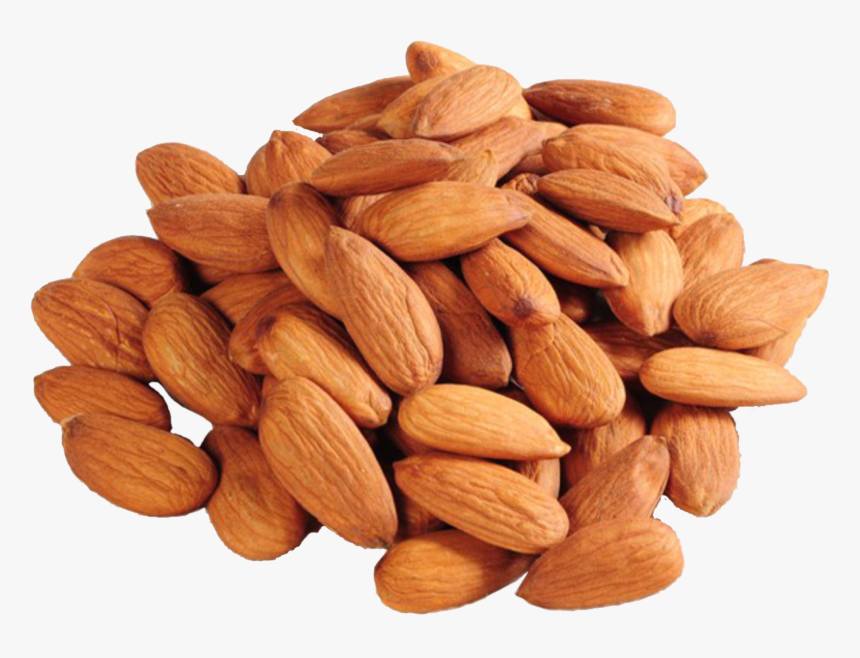
Mamra Almond
Features and Benefits
In other words, Mamra almonds have as much as 50% oil, while the typical California almond only contains between 25% and 30% oil. As an excellent source of protein, amino acids, minerals, and vitamins, Mamra Almonds are an excellent choice. Pregnant women may benefit from eating almonds; however, those on a strict diet may choose the less expensive California Almond kind.
Mamra Badams have more oil than other types of almonds and is useful for boosting good cholesterol levels. “Good” cholesterol, or HDL, can be raised by eating Mamra Badams, which are rich in monounsaturated fatty acids (HDL). This means that the cholesterol in mamra badam is healthy. In the following, we’ll discuss nutrients in further detail.
Among mamra almond benefits, we can say this type of badam has helped conditions including coronary artery disease and strokes by promoting a healthy lipid profile in the bloodstream. Skin disorders, anemia, and respiratory illnesses can all be prevented with Mamra Badam.
Mamra Badam Oil
The oil in Mamra Badam is where most of the nutrients are found. However, despite its increased oil content, Mamra Badam can raise “good” cholesterol levels and lower “bad” cholesterol, or low-density lipoproteins (LDL), when saturated and trans fats replace it in the diet.
Mamra Almonds’ Nutritional Profile
In addition to having identical nutritional qualities to conventional almonds, the Mamra Almonds contain approximately twice as much oil as their standard counterparts. These monounsaturated oils are thought to be helpful because they help lower bad cholesterol and raise good cholesterol in the body.
Complex carbohydrates, protein, iron, fiber, and magnesium are all included in Mamra almonds, which are also a good source of Vitamins B1, B2, P, and E. Additionally, eating a handful of mamra almonds will provide you plenty of energy to get through your day.
Mamra Almonds provide 609 calories, 3.4 grams of carbs, 18 grams of protein, 58 grams of fat, 14 grams of dietary fiber, 2.3 grams of sugar, and 1.5 grams of salt per 100 grams. It is higher in fiber, protein, omega-3 fatty acids, and calories than normal almonds and much higher in fat and calories. Also, if you are wondering what is mamra giri? It’s a superior type of mamra almond with zero cholesterol, artificial coloring, and harmful chemicals. It’s much more expensive than regular mamra almonds.
After purchasing mamra almonds, should we soak them?
It is advisable to soak Badams of all kinds before eating them, which is also true of Mamra Badams. Badams’ tannin-rich skin makes it difficult for the plant’s nutrients to be absorbed. Soaking the badams overnight and then peeling off the skin before eating them is the best way to get the most benefit and nutrients out of them.
Mamra Almonds vs. Normal Almond
What is mamra badam? Mamra Almonds are distinct from regular almonds not only in shape but also in taste and nutrient profile. The cervical shape and crispy flavor of Mamra Almonds set them apart from normal Almonds. These nuts, with their distinctive cervical shape, are among the most expensive on the market. They make up only 5% of the world’s almond production, with the remainder going to normal almonds.
How to recognize Mamra almonds apart from other kinds of almonds?
Mamra Almonds have a cavity on the front; however, normal or California Almonds are convex on both sides. Also, Mamra almonds aren’t as sweet or delicious as regular almonds, but mamra almonds benefits can help hide that.
Are Mamra almonds more nutrient-dense than normal almonds?
They’re ten times as nutrient-dense as a regular almond. Pasteurized almonds, which are used to make almond oil, lack some of the nutrients found in their natural state. Compared to a typical almond, which is large and round with little fat, mamra tends to be more slender.
The enormous health benefits of almonds place them at the top of the list of nuts. Vitamin E, magnesium, manganese, protein, fiber, and antioxidants are abundant in this food. Marketed and grown in various parts of the world, several notable almond types can be found.
Only 4% to 5% of the world’s almonds come from the Mamra variety. Best mamra almonds are grown in Afghanistan and Iran. The normal almond variety accounts for 85% of the market and has a higher yield and productivity. Their market price is low and readily available due to massive production. Compared to regular almonds, marma contains the most carbohydrate and oil content and the most calories. As an energy food, it has a lower protein value than a normal almond and is also high in sugar content.
Mamra Almonds have several health benefits
Cholesterol-lowering properties of Mamra Almonds are well-known
The fact that original mamra badam contains zero cholesterol is probably the most distinguishing feature that sets them apart from other types of almonds. A higher concentration of monounsaturated oils in Mamra almonds aids in reducing bad cholesterol while simultaneously promoting the growth of healthy cholesterol. Doctors advise people with high cholesterol to eat mamra almonds to lower their cholesterol levels.
Enhances brain functionality
The widespread belief in Indian families is that almonds are a great way to improve neuron system activity and promote brain health. Mamra Almonds are rich in important nutrients that help alleviate stress on the nervous system and boost overall mental efficiency.
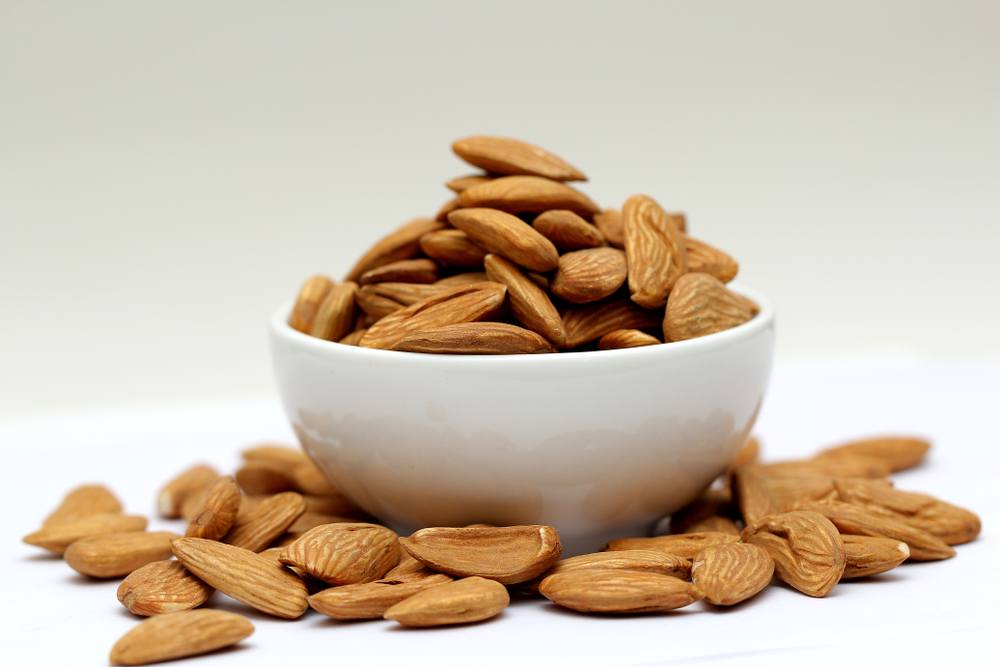
Mamra almond health benefits
In addition to lowering the potential risk of heart diseases, Mamra almonds have been shown to improve heart health
Mamra Almonds have anti-inflammatory characteristics that are critical in maintaining a healthy heart and avoiding various cardiac disorders, such as heart attacks and mild or severe strokes, in addition to decreasing cholesterol and soothing the nervous system. Adding mamra almonds to a patient’s diet and consuming them every day can help prevent a heart attack, according to doctors.
Aims to relieve joint discomfort and strengthens the bones and teeth
In addition to Vitamin E and Phosphorus, Mamra almonds are a good source of calcium and magnesium. These nutrient components are also useful in getting rid of joint discomfort. Adding mamra almonds to your diet might help relieve joint discomfort while strengthening your bones.
Mamra Almonds are beneficial to the digestive system
Eating Mamra Almonds regularly may help one’s digestive tract function more efficiently, resulting in softer bowel movements. Additionally, a diet high in fiber is critical for maintaining a healthy digestive system. Even though eating too many mamra almonds might lead to several digestive disorders, it is recommended that you do so in moderation.
What Are Blanched Almonds?
The blanched almond is a common ingredient in many recipes. Blanched almonds have had their skins removed by boiling them for a brief period of time. Because blanched and unblanched almonds have very little difference, they can be swapped for each other in the same quantities. The calorie and fiber content of blanched almonds appear to be unaffected. Regarding the calorie count, blanched almonds have 165 calories per one-ounce serving, while unblanched almonds have 162. A few reasons exist for removing the skins.
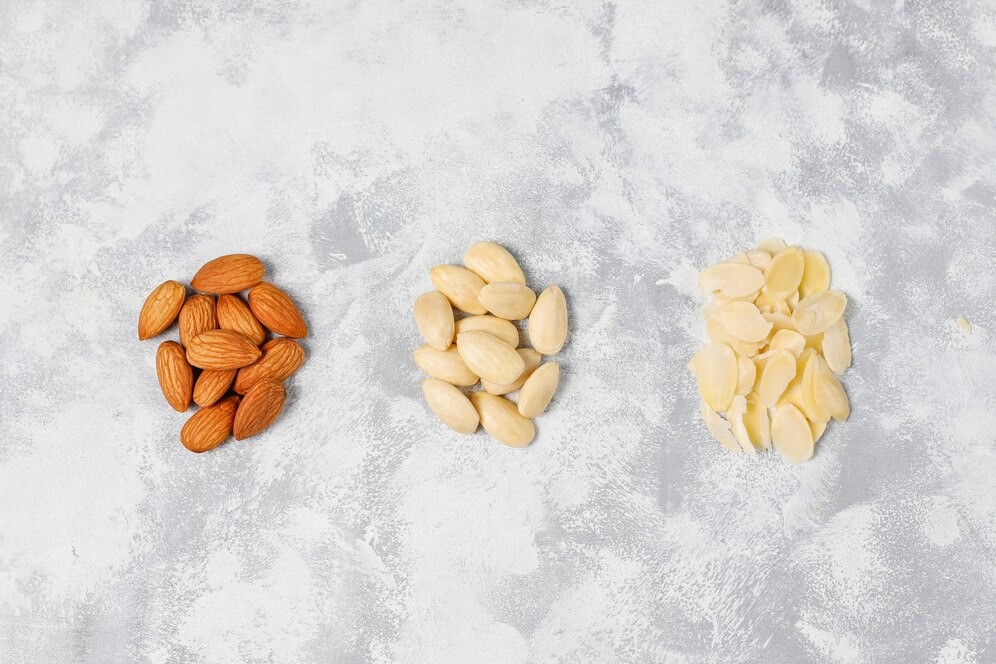
Blanched Almonds Vs. Unblanched
First and foremost, there’s the look and feel. The color of the almond skins can influence the appearance of the dish. You may not want to use almond flour with flecks of almond skin, for example, if you want uniformly colored macaron shells. As a bonus, blanched almonds can brighten up a veggie dish.
The second one is taste. To protect the almonds, tannins are found in the skin. Tannins are astringent chemicals, making the mouth feel dry because of their reaction to salivary proteins. Additionally, these chemicals contribute to black tea and wine’s dryness. The astringency and bitterness in a meal can be reduced or eliminated entirely by removing the peels.
Third, almonds’ skins have an impact on their nutritional value. Tannins, which are found in almond skins, can interfere with the absorption of nutrients in the body. However, human systems can digest almond skins, and no scientific research has shown that consuming almond skins is harmful. Let’s see how to make blanched almonds.
How To Make Blanched Almonds?
Only a few minutes are needed to blanch almonds (badam). Measure out the desired amount of raw almonds and heat the water to boiling in a large pot. A large enough ice water dish should be ready for the almonds.
Add the almonds to the boiling water and cook for one minute. This is NOT the time to walk away from the pot. If you overcook your almonds, they will become mushy and gummy. The water will turn brown as the tannins in the skin of the almonds begin to break down during the boiling process.
After removing them from the boiling water, place the almonds in a bowl of ice water. When the almonds have cooled enough to handle, proceed with caution. Around the nut, the skins should be a little slack.
It’s time to have some fun! Squeeze an almond till it bursts out of its covering. Don’t squeeze it so tight that it flies out of your hands. Scraping could be necessary to get rid of stubborn skins. Each almond should be peeled, and the process should be repeated for each one.
When you’ve removed all the skins from your blanched almonds, spread them on a cookie sheet or plate to dry. To make sure they haven’t turned rubbery, you are free to toast them.
Blanched almonds can be used in any recipe that calls for them once they have dried. Also, you can use mamra almonds instead of normal almonds on the market and have a more nutritious recipe. You may use blanched almonds in various ways, including chopping them, grinding them in a food processor or blender, or eating them whole. Infuse olive oil with blanched almonds, bake gluten-free pumpkin bread, garnish salads with blanched almonds, or make a paleo breading for poultry. You’ll know precisely what to do with it when you see blanched almonds in a recipe.
Almond Recipes, Different Ways Of Using Almonds in Cooking
What could be more delightful than a handful of crunchy, nutty almonds? You can always count on Almond Recipes, no matter what you are looking for. As a result, it’s no surprise that they’ve become a staple in many households, including mine. Almonds (Badam) are versatile tree nuts that are used for a wide range of culinary purposes. These crisp nuts are good for you in more ways than one, and not only because of their delicious flavor and adaptability. Almonds, rich in heart-healthy minerals, are a delicious and nutritious addition to any meal or snack.
Five of the Best Uses for Almonds in Almond Recipes
Serve Fruit with Almonds as a Snack
Almonds are a great way to elevate a regular fruit dish like fruit salad, baked grapefruit, or fruit cobbler to a whole new level of deliciousness. For instance, fresh figs sautéed with almonds, cinnamon, and cardamom make for a delicious, low-sugar fruit treat called “Sautéed Figs with Cinnamon and Almonds.” In Almond Recipes, you can use almonds as a topping for pancakes, waffles, vegan vanilla ice cream, or sorbet.
Sautéed Figs with Cinnamon and Almonds

Ingredients
- 2 pounds fresh figs (about 24 small figs)
- 1 ½ tablespoons extra virgin olive oil
- ½ teaspoon cinnamon
- ¼ teaspoon cardamom
- 1/3 cup almonds, slivered
- ¼ cup sweet white wine
Method
- After figs have been washed and their stems removed, they should be cut in half lengthwise.
- Warm the olive oil in a frying pan. Season with cinnamon and cardamom.
- To soften figs, sauté them in olive oil for about 7 minutes.
- When the sauce has thickened and is bubbling, add the almonds and white wine and continue to cook for another 2 to 3 minutes.
- Serve these tasty figs warm.
Add some almonds to your favorite baked goods for a tasty twist
Almonds are a fantastic addition to a wide variety of baked goods, including cookies, bars, crumbles, and coffee cakes. For instance, you may make a delightful Strawberry Coconut Almond Coffee Cake with ingredients like strawberries, aquafaba (bean water), brown sugar, vanilla, plant-based milk, coconut or vegetable oil, flour, baking powder, shredded coconut, and slivered almonds. Looking for something that can be prepared quickly, has a low sugar content, and goes well with English tea? This recipe for Lavender Almond Cookies calls for dried lavender flowers, sliced almonds, almond flour, and aquafaba to make chewy, flavorful, and not overly sweet lavender cookies.
Lavender Almond Cookies

Ingredients
- 1/2 cup aquafaba
- ¾ cup organic cane sugar
- 3/4 cup dairy-free margarine, soft
- 1 teaspoon pure vanilla extract
- ¾ cup almond flour or meal
- 1 ½ cups enriched, unbleached wheat flour
- 1 teaspoon baking powder
- ¼ teaspoon salt (optional)
- 2 tablespoons dried lavender flowers
- ¼ cup chopped almonds
Method
- For a preheated oven, set the temperature to 325 degrees Fahrenheit.
- Whip the bean liquid (aquafaba) and sugar together in a large basin until soft peaks form, using an electric mixer (about 3-4 minutes).
- Blend the vanilla extract and margarine together gently.
- Add the almond flour, enriched flour, baking powder, salt (recommended), lavender flowers, and almonds to a medium bowl and stir to combine.
- The dry ingredients should be folded into the aquafaba mixture very gently.
- Put nonstick cooking spray on two baking sheets. Place spoonfuls of batter on a baking sheet.
- Put it in the oven for about 18 minutes, until the edges are firm and brown.
- Take the dish out of the oven and let it cool.
Blend some almonds into a tasty smoothie
Almonds provide a nutty flavor and a healthy dose of protein and fat when blended with fruits and vegetables. Smoothies are one of the most delicious mamra almonds recipes. Almonds are a great addition to smoothies since their mild flavor means you can sneak in a third serving of nuts without changing the taste. And you shouldn’t limit yourself to just sweet smoothies; try savory, nutrient-rich Zesty Tomato Smoothie, which features canned tomatoes, almonds, plant milk, lime, onions, jalapeno, cilantro, and a pinch of smoked paprika and black pepper. Among Almond Recipes, smoothies are versatile enough to serve as a quick breakfast, post-workout recovery drink, or satiating snack. Another easy and fast to prepare mamra recipe we suggest is to use mamra almonds in milkshakes to enjoy a more nutritious dessert.
Mamra Almond Milkshake
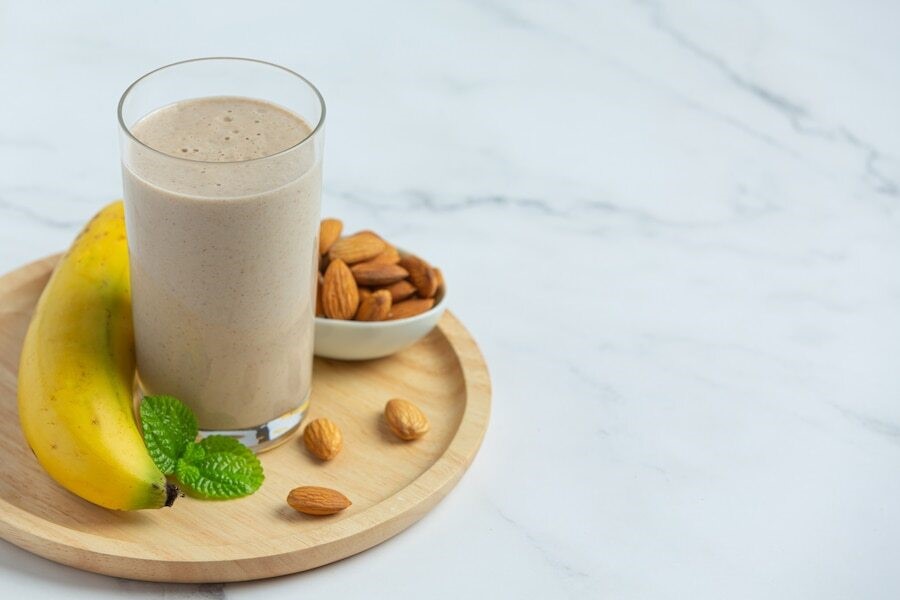
Ingredients
- 2 cups full fat milk
- 3 tablespoons sugar
- 2 teaspoons pure vanilla extract
- 1 teaspoon of pure mamra almond extract
- 2 scoops vanilla or almond ice cream
Method
- For best results, boil the milk and then let it cool in the fridge for three to four hours.
- Put 15 mamra almonds in boiling water for 5 minutes to “blanch.” Take off the skins and throw them away.
- Combine almonds that have been peeled, sugar, and vanilla in a blender jar. Add the milk, 1/4 cup, and blend until it’s a smooth paste.
- Blend again until smooth and frothy, adding ice cream and the remaining milk.
- Serve the mamra almond shake with ice cream on top right away.
Spread on some almond butter
Almond butter is a great option if you’re looking for nut butter that’s both smooth and delicious. Almond butter can be used as a fat substitute in cooking and baking or simply spread on toast, sandwiches, or bananas (margarine or oil). Almond butter makes a delicious dip for cut fruits and vegetables and is a healthy addition to yogurt, oatmeal, and smoothies.
Homemade Mamra Almond Butter
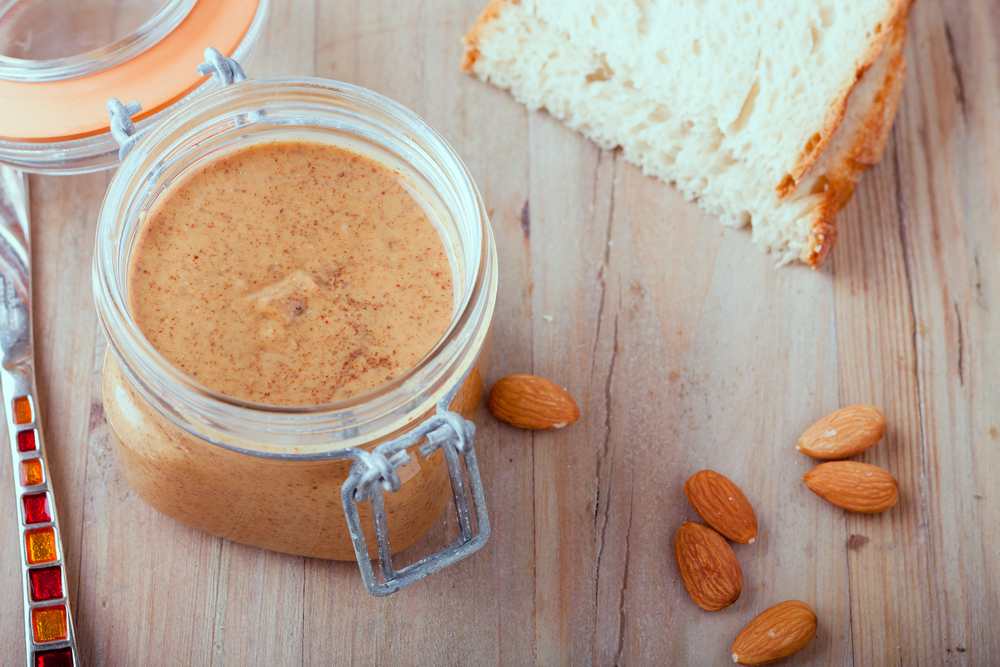
Ingredients
- 16 ounces (3 cups) raw mamra almonds
- ¼ teaspoon salt
- Optional: ¼ teaspoon ground cinnamon
- Optional: ½ teaspoon vanilla extract
- Optional: 2 tablespoons maple syrup or honey
Method
- Preheat oven to 350°F. Toast almonds at 350 degrees for 10 minutes, stirring halfway.
- Wait 10 minutes, until almonds are warm but not hot.
- Blend or process the almonds. Scrape down sides while blending. You’ll feel like it’ll never come together, but be patient. Keep scraping the sides of the food processor and breaking up the almond ball until it becomes smooth and creamy. If the mixture gets too hot, pause for a few minutes.
- Once the almond butter is smooth and creamy, add flavorings (but not before). Salt improves everything, in my opinion. Cinnamon, vanilla, maple syrup, or combined can make almond butter gourmet.
- Blender ingredients. After adding maple syrup, I had to let the mixture cool before continuing to mix.
- Transfer the almond butter to a mason jar and seal it. Keep in the fridge for up to 2 weeks before discarding.
Mix into a Cream or Dip
Vegan savory Almond Recipes like veggie meatballs, lentil patties, or baked potatoes would benefit from almonds’ rich, plant-based touch in a creamy dip or sauce. Sage and cranberries are optional; additional flavor combinations include basil, sun-dried tomatoes, or cilantro and jalapenos. Moreover, unsoaked almonds can be processed into an almond cotija or parmesan, and raw almonds can be enjoyed as soft cheese or ricotta after being soaked.
Almond Veggie Meatballs

Ingredients
- 1/2 cup raw almonds
- 1 head broccoli broken into florets and steamed (about 2 cups)
- 1/2 cup shredded Parmesan cheese
- 2 cloves garlic minced
- Salt and pepper to taste
- 1 egg lightly beaten
Method
- Set oven temperature to 350 degrees F. Lightly oil or spray a mini-muffin tin with cooking spray.
- The almonds should be finely crushed in a food processor and then transferred to a mixing bowl.
- In a food processor, pulse the broccoli florets until finely chopped. Mix together the ground almonds, broccoli, cheese, and garlic in a large bowl. Put in the egg and season with salt and pepper to taste.
- Squeeze each broccoli ball to ensure it retains its shape, and then set it in a muffin cup. Repeat with the remaining ingredients.
- To achieve a golden brown color and a slight crunch on the outside, bake the meatballs for 20 minutes. After 5 minutes, take the pan out of the oven and let it cool; then, using a butter knife, loosen the meatballs in each muffin cup and pop them out.
How to Roast Almonds?
When roasting raw almonds in the oven, almonds transform from a mild, chewy nut into a tasty, crispy snack. Roasting or toasting almonds in the oven or on a frying pan brings out their full flavor, which is quite mild when raw.
Ingredients
All you need are raw almonds to make a delicious almond roast. If you wish to roast them in the oven at home, you should get the raw type from the grocery store.
Additional ingredients for roasting raw almonds, if desired:
- Using butter or oil gives the almonds a richer, more buttery flavor.
- Seasonings are a great way to give almonds a unique taste.
- If you are a fan of spice blends, sprinkle some on them.
- Looking for some sugar to satisfy your sweet tooth? Add some cinnamon and sugar if you like sweet almonds.
- The salt complements the nutty flavor of the almonds and helps bring out their natural flavor.
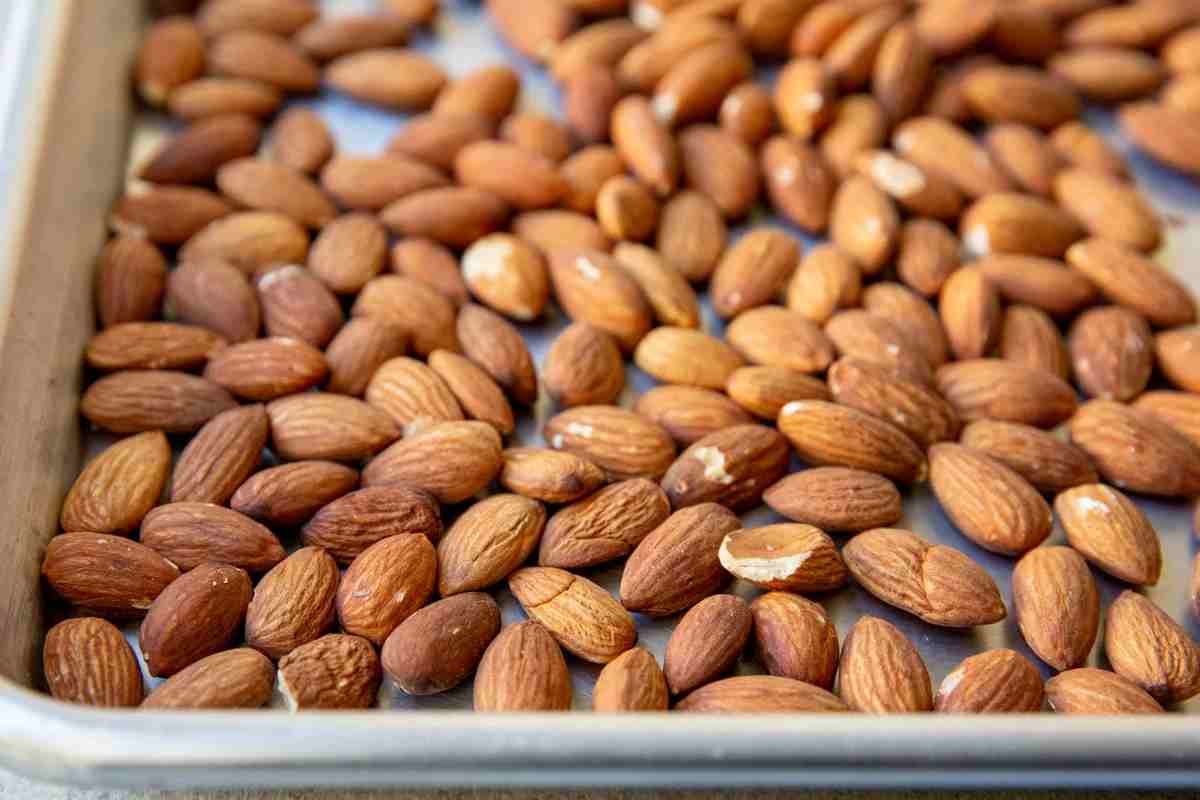
Instructions for Roasting Almonds
Almonds can be roasted in the oven or toasted in a skillet. If you’re using seasonings, toss them with oil or melted butter before you roast or toast them. It’s not necessary at all, by the way.
Roasting Raw Almonds in Oven:
Roasting raw almonds in the oven is simple and convenient. To roast almonds, you should:
- Set the temperature to 325 degrees.
- Make sure you use a big, light-colored baking sheet and line it with parchment paper.
- Almonds should be spread out in a single layer on the prepared baking sheet.
- In general, for roasting almonds, you should roast whole almonds for 9-12 minutes, sliced almonds for 6-8 minutes, and slivered almonds for 7-9 minutes.
- Halfway through cooking, give them a shake or stir to ensure they aren’t burning.
Roasting Raw Almonds in a Pan:
- You can toast a moderate to big amount of nuts on the stovetop.
- Prepare a medium to big, dry, nonstick skillet by heating it over low to medium heat.
- Spread out no more than one cup of almonds in the pan.
- Toast for three to five minutes, shaking the pan occasionally.
Almonds Nutrition Facts
Let’s take a look at Almonds Nutrition Facts. Almonds are a versatile and healthy addition to any diet because of their versatility in preparation and consumption. Salted, unsalted, raw, and roasted almonds are available for purchase. Almonds, like many other nuts, can serve several purposes. You can mash them up into almond butter, churn them into almond milk, or grind them into almond meals.
Studies suggest that a diet rich in nuts may improve cardiovascular health and provide other advantages to the body.
Never underestimate the nutrition value in almonds. Protein, fiber, and micronutrients like vitamin E and iron are all provided by almonds, making them a potentially excellent choice. Those with hypertension or a desire to reduce their sodium intake will appreciate knowing that almonds, both raw and roasted, contain no sodium. Approximately 24 whole almonds (Badam) make up one ounce (28g), and the Almonds Nutrition Facts data presented here is given by the USDA:
- Calories: 164
- Fat: 14.2g
- Sodium: 0.3mg
- Carbohydrates: 6.1g
- Fiber: 3.5g
- Sugars: 1.2g
- Protein: 6g
Carbs
In a single serving, almonds provide 6.1 g of carbohydrates. Almonds are a great option for those trying to cut back on carbohydrates because they contain a lot of fiber (more on this later) and have a lower glycemic index than other nuts.
Fats
One ounce of almonds contains about 22 percent of the daily value for fat, making them high-fat food. However, almond fat is predominantly monounsaturated, which has been shown to reduce the risk of cardiovascular disease. A handful of almonds has about 1 gram of saturated fat, 9 grams of monounsaturated fat, and 3.5 grams of polyunsaturated fat.
Protein
Almonds contain all the essential and non-essential amino acids in relatively tiny levels, making them a good plant-based protein source. The protein content of almonds is 6 grams per ounce.
Vitamins and Minerals
There is 37% of the DV for vitamin E in almonds, 8% of the DV for calcium, and 6% of the DV for iron in just one ounce.
Vitamin E has been shown to have antioxidant and immune-boosting effects. Calcium plays a vital role in preserving bone and tooth structure. Hormone synthesis and muscle oxygenation are both aided by iron.
Magnesium
In addition to maintaining appropriate nerve and muscle function, magnesium also plays an important role in protein synthesis and the body’s ability to convert food into usable energy. Magnesium helps keep bones healthy and supports healthy mental and emotional functioning; it also helps combat exhaustion and tiredness. For one mineral, that’s a lot of employment opportunities. A handful of almonds (weighing 30 grams) contains 20 percent of the NRV for magnesium, making them a great food source. Magnesium’s potential health benefits in hypertension, cardiovascular disease, diabetes, and osteoporosis are still the subject of active investigation. While some studies have examined whether magnesium can help with sleep, anxiety, or depression, the results have been mixed.
Fiber
There are two types of fiber present in almonds, soluble and insoluble. The insoluble fiber makes food more substantial, speeding up the digestive process. Reduced LDL cholesterol levels and better regulation of blood sugar are two of the many beneficial effects of soluble fiber. In a 30-gram portion, Almonds deliver 4 grams of fiber, 6 grams of energizing plant protein, and healthy fats to keep you going between meals. Most people are under the impression that the skin of almonds is the only place to get fiber. Even when the skin is removed, there are still 3 grams of fiber in 30 grams of blanched almonds.
Calories
One ounce of almonds contains 164 calories, making them a high-calorie food. Healthy fat makes up the bulk of the caloric content, with protein and carbs making up the remainder. Almonds Nutrition Facts are many, and we only discussed them briefly.
Do mamra almonds have the same nutrition facts as normal almonds?
We talked about the benefits of mamra almonds in previous sections of the article. Also, don’t forget about the almond milk nutrition facts, either. Mamra almond milk is way more beneficial for athletes than normal almond milk; the sugar is almost zero! Less than one gram. Now let’s take a look at Mamra almond nutrition facts.
- 609 kcal
- 3.4g of carbohydrates
- 18g protein,
- 58g of fat
- 13g of dietary fiber
- 2.3g of sugar
- 1.5g of sodium
Almonds Health Benefits
Nutrient-wise, almonds are a real powerhouse. Almonds (Badam) are excellent in any form, whether eaten whole, chopped, sliced, or crushed into flour or Almond butter. Here are six Almonds Health Benefits supported by studies.
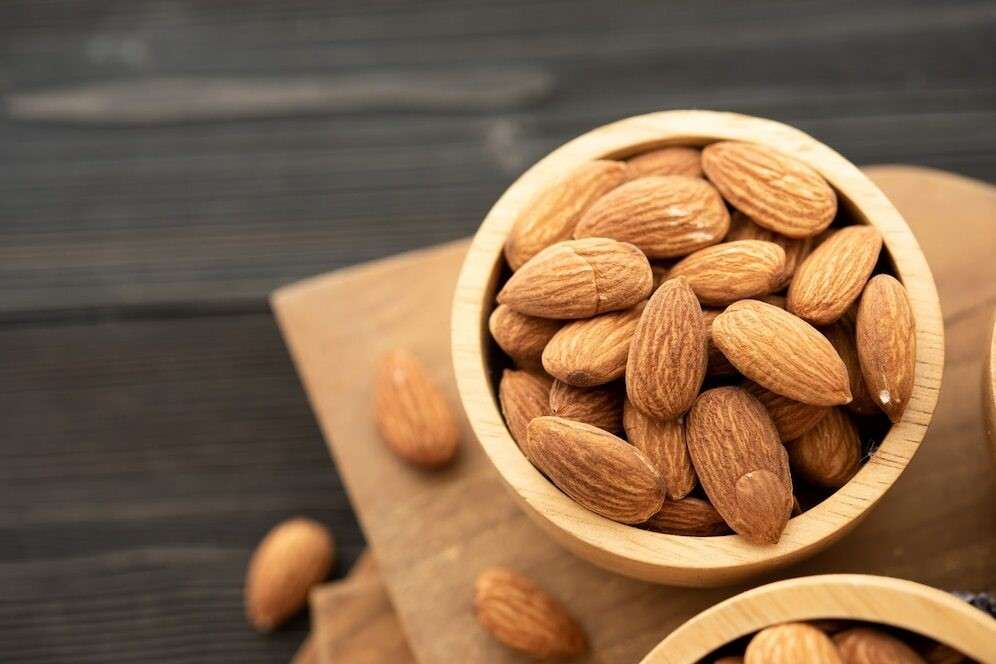
Nutrient-dense
About 23 almonds (or a quarter cup) contain a generous amount of heart-healthy fat, 6 grams of plant protein, 4 grams of filling fiber (13% of the daily minimum), half the daily target for vitamin E, and 20% for magnesium, as well as B vitamins and smaller amounts of calcium, iron, and potassium.
Antioxidant vitamin E has been related to protection against neurodegenerative disorders such as Alzheimer’s disease, as well as to a variety of other Almonds Health Benefits, including but not limited to boosting the immune system and lowering inflammation. As well as helping keep blood sugar and blood pressure in check, magnesium also plays a role in maintaining a healthy brain, mood, and sleep. Almonds aid in bone health due to the wide range of nutrients they supply.
Packed with a high concentration of antioxidants
The brown skin of almonds is where most of the almond’s antioxidants are found. Blood levels of indicators for oxidative stress were shown to fall by as much as 28 percent in men and women who consumed 2.5-3 ounces of almonds daily over one month, according to a recent study (by the trusted Almond Board of California). When there is a discrepancy between the generation of free radicals that damage cells and the body’s ability to neutralize them, oxidative stress occurs. They attribute the beneficial effect of almonds to the antioxidants found in them.
Almonds improve gut health
Prebiotics like those found in raw and roasted almonds provide nourishment for the probiotic bacteria in the stomach, which have been associated with improved immunity, reduced inflammation, and improved mental health. Students in a recent study were given either almonds or graham crackers as a study snack. Eight weeks later, the gut microbiome composition of the almond eaters had changed significantly, with less a harmful bacterium and more the bacteria linked to favorable outcomes such as Managing weight, insulin activity, controlling cholesterol, and reducing inflammation.
They are good for your heart’s wellness
In multiple ways, almonds shield your heart from harm. Nuts have been demonstrated to reduce “bad” LDL cholesterol levels while maintaining or increasing levels of “good” HDL cholesterol, which protects the heart.
It has been shown that eating nuts like almonds can help lower blood pressure and enhance vascular function by relaxing blood vessels and lessening arterial stiffness. For example, in one trial, patients with high cholesterol were divided into two groups: one ate a cholesterol-lowering meal that included 1.5 ounces of almonds. In contrast, the other ate a nut-free muffin with the same number of calories. The nut eaters lowered LDL, but HDL remained stable after two weeks. In addition to losing weight overall, those who ate almonds also lost weight in their midsections and thighs.
Almonds can help in controlling weight
Almond consumption, along with other tree nuts, has been linked to a lower body mass index (BMI; a ratio of a person’s weight to their height) and smaller waist circumferences. Almonds are not only filling, but their combination of healthy fat, plant protein, and fiber also makes them effective at delaying the onset of hunger pangs. Additionally, recent studies have shown that the calorie count of almonds is lower than that stated on the packaging by roughly 20%. This is because some calories are lost during digestion and therefore never absorbed into the bloodstream.
They are beneficial for the skin
Among Almonds Health Benefits, the skin benefits from excellent fats, and almonds may help reverse the effects of time on the skin. During a 2019 randomized controlled trial. The study included a split between two groups of healthy postmenopausal women. The almond group spent 16 weeks eating 20% of their calories from almonds. In contrast, the control group consumed the same amount from non-almond sources. The depth and breadth of wrinkles were measured at the beginning of the study and then again eight and sixteen weeks later, using photographs of the participants’ faces and an image analysis system. The severity and width of wrinkles were significantly reduced in the almond group compared to the non-almond group. Not bad for a great food with so many advantages!
Now let’s briefly take a look at Mamra almonds health benefits.
The benefits of mamra almonds are:
- Excellent Source of Vitamin E
- Rich in Protein, Fiber, and Minerals
- Super Healthy
- Heart Friendly
- Reduces Cholesterol
- Improves Metabolic Rate
- Good for Bones and teeth
- Good for Diabetes
- Weight Loss
- Beneficial to the Brain’s Function
- Memory Boosting
Mamra Almond Price
Mamra Badams can only be grown in specific areas through conventional means. The Mamra Almond Price depends on several elements, including the soil quality, pH levels, weather, and terrain. In terms of quality, there is no better almond than the Mamra, which makes up around 5% of total global almond production. This causes the price of mamra almonds to rise to three times as much as other types of almonds.
How Come Mamra Badam Costs So Much?
It is possible to spot a Mamra badam, or Mamra almond, by its distinctive concave shape and small size. The origins can be traced back to Afghanistan and Iran. Nuts of this quality only come from specific places and are harvested using time-honored practices. In terms of the health of your brain, the Mamra badam is the greatest almond variety you can buy. The growth of a healthy brain requires a steady supply of riboflavin, often called vitamin B2, and valproate. Even though they’re heavy in fat, Mamra badams are nevertheless considered the highest quality sign of success and prestige.
Mamra Badam 1kg Price
Given the cost of mamra badam production, mamra badam is reasonably priced at one kilogram. For human consumption, nothing beats the assurance of knowing that your food was grown and harvested in a completely organic manner. As previously noted, global Mamra output hovers around 4-6% annually. Due to the limited nature of its production, which occurs in only three regions, prices vary depending on where the snacks are purchased. It is time to take a close attention at the prices in each group. The mamra almonds 1 kg price is between $50 and $60. However, the quality of the goods you’re purchasing and the store you make your purchase from can both affect the final price you pay.
Kashmiri Mamra Price
The finest of all, Kashmiri Mamra. There are a variety of packaging options. It’s possible to purchase Badam in 200-, 250-, 500-, and 1-kilogram packages. As a result, the price shifts in this way. Two hundred grams of Kashmir Mamra, for instance, may set you back around $7. Similarly, you may purchase 250 grams of mamra for $7.5-$8.5. 500 grams may run you about $20-$25, while a kilogram could set you back to $40. Mamra Almond Prices may vary. However, it is recommended that you do your shopping from a reliable source.
Afghani Mamra Price
Afghani mamra has different values depending on their quality. Since you never know what you’ll get from one dealer to the next, the Mamra Almond Price varies depending on their grades. Afghanistan’s mamra can range in price from $20 to $50 per kilogram. Once again, everything rides on the quality. Depending on quality and market demand, the price of 200 grams of Afghan mamra can range from $9 to $12. Some estimates put the price of 250g at $16.
Iranian Mamra Price
Irani mamra is perhaps the oldest mamra type currently in use. The original royal mamra, if you will. Delicious and nutritious, these greens are a staple of Iranian cooking—delicious and healthful snacks with a bold Iranian flavor and spirit. The exotic Iranian dry fruits known as Mamra are loaded with minerals that are good for you. Irani mamra badam price for every 200 grams is between $9 and $12. The price for 250 grams of Iranian Mamra can range from $16 to $35. However, the average price per kilogram might range from $75 to $90. The high cost of Mamra Almond Price can be explained by the fact that a large percentage of the world’s supply comes from Iran. Also, the mamra giri badam price is much higher than other mamra types on the market.
Order Mamra Almonds From Keinia
You can order mamra almonds in little or large quantities, at retail or wholesale costs from us. Bags range from 250g to 5kg in weight and larger. You can pick a date and time that works best for you to receive these products.
Order mamra almonds online to cut down on time and effort
Are you looking for a place to buy almond online? Here, you will find a vast selection of high-quality almonds at a very reasonable price. We only offer Iranian-cultivated almonds, such as the Irani mamra almond and other varieties. As a company, we sell to both corporations and individuals. You can now purchase the best mamra almonds online from the convenience of your own home. We provide a money-back guarantee on all of our products.
Fresh from the Farms of Iran
For a variety of reasons, we love our almonds. If you want to improve your health, you’ll find plenty of reasons to eat them. Snack on them throughout the day, or include them in your favorite dishes for an extra dose of nutrition. Order mamra almonds and have a feast with your family and friends.
It’s Easy and Convenient to Order Mamra Almonds Online
The resealable bags we use for our products make them more convenient to handle and help preserve their freshness. Keinia mamra almonds will appeal to anyone who likes these particular nuts’ flavor. To place an online order, don’t hesitate to get in touch with us. If you have any concerns regarding our products, please do so. We will respond as quickly as possible. Contact us for more information.
- References:
- https://www.tarladalal.com/glossary-almonds-badam-378i
- https://www.thespruceeats.com/almond-fact-sheet-1807487
- https://www.liveeatlearn.com/almonds/
- https://www.hsph.harvard.edu/nutritionsource/food-features/almonds/
- http://www.ers.usda.gov/data-products/fruit-and-tree-nut-data/yearbook-tables.aspx
- https://www.livescience.com/28945-american-culture.html
- https://www.livescience.com/51627-almonds-nutrition.html
- https://www.medicalnewstoday.com/articles/269468
- https://www.homestratosphere.com/types-of-almonds/
- https://indiagardening.com/a-little-more-than-gardening/almond-varieties-in-india-types-of/
- https://rapidleaks.com/lifestyle/food-drink/different-types-almonds/
- https://biowellbeing.com/types-of-almonds/
- https://www.24mantra.com/blogs/organic-food/12-types-of-almonds-you-didnt-know-of/
- https://www.britannica.com/plant/almond
- https://www.mymillets.com/products/mamra-badam
- https://healthymaster.in/blogs/mamra-almonds-benefits/https://the-gulmarg.com/kashmiri-mamra-almonds/
- https://the-gulmarg.com/kashmiri-mamra-almonds/
- https://www.quora.com/What-are-mamra-almonds
- http://www.caryopses.com/dry-fruits/nuts/mamra-almonds/cashew06
- https://the-gulmarg.com/kashmiri-mamra-almonds/
- http://dietplusminus.com/weight-loss/which-almond-is-better-california-mamra-or-gurbandi/
- https://www.qries.com/Which-almond-type-whether-Mamra-Gulbandi-or-Californian-is-better
- http://bowlofnuts.com/almonds/important-nutritious-and-health-benefits-of-mamra-almonds/
- https://www.quora.com/What-is-the-Comparison-between-mamra-and-California-almonds
- https://nativetongue.in/blogs/recipes-more/know-your-almonds-gurbandi-vs-mamra-vs-california
- https://healthymaster.in/blogs/mamra-almonds-benefits/#:~:text=Mamra%20Almonds%20are%20quite%20different,shape%20and%20their%20crispy%20taste
- https://foodtasia.com/blanched-almonds/
- https://toriavey.com/how-to-cooking-methods/cooking-tutorials/how-to-blanch-almonds/
- https://spoonuniversity.com/lifestyle/what-are-blanched-almonds
- https://theloopywhisk.com/2018/03/27/how-to-blanch-almonds-in-under-5-minutes/
- https://www.seriouseats.com/how-to-blanch-almonds
- https://www.myrecipes.com/ingredients/almond-recipes
- https://www.acouplecooks.com/almond-recipes/
- https://ndb.nal.usda.gov/ndb/search/list?home=true
- https://www.mdpi.com/2072-6643/10/4/468
- https://doi.org/10.1016/j.ihj.2018.01.030
- https://www.hollandandbarrett.com/the-health-hub/food-drink/recipes/nuts/great-ways-to-use-almonds/
- https://sharonpalmer.com/dirt-report-almonds/
- https://www.rachelcooks.com/olive-oil-roasted-almonds/
- https://www.bbcgoodfood.com/recipes/roasted-salt-paprika-almonds
- https://snack-girl.com/snack/how-do-i-roast-almonds/
- https://www.thekitchn.com/how-to-toast-nuts-in-the-oven-cooking-lessons-from-the-kitchn-181294
- https://www.jcsqualityfoods.com.au/recipe/how-to-roast-almonds/
- https://www.culinaryhill.com/how-to-roast-almonds/
- https://www.medicalnewstoday.com/articles/269468
- https://www.livescience.com/51627-almonds-nutrition.html
- https://www.hsph.harvard.edu/nutritionsource/food-features/almonds/
- https://nuthealth.org/nut-facts/almonds/
- https://www.verywellfit.com/almond-nutrition-facts-calories-and-health-benefits-4108974
- https://www.almonds.com/why-almonds/snacking
- https://www.webmd.com/diet/health-benefits-almonds#:~:text=Almonds%20are%20rich%20in%20valuable,a%20nutritious%20and%20filling%20snack.&text=Almonds%20have%20calcium%20and%20phosphorus,can%20protect%20you%20from%20fractures.
- https://www.healthline.com/nutrition/9-proven-benefits-of-almonds#TOC_TITLE_HDR_2
- https://www.tasteofhome.com/collection/health-benefits-of-almonds/
- https://www.health.com/food/health-benefits-almonds
- https://www.lifehack.org/369782/amazing-benefits-almond-5-refreshing-recipes
- https://www.mymillets.com/products/mamra-badam
- https://the-gulmarg.com/kashmiri-mamra-almonds/
- https://healthymaster.in/blogs/mamra-almonds-benefits/

